Features of recirculation hoods
The range hood is an essential item in the kitchen. However, the standard option, when the device is connected to the duct and draws air into the ventilation shaft, may not always be used.
In such cases, you can use an alternative: now there are hoods with a recirculation mode that do not need to be connected to the ventilation duct.
The principle of operation and features of the device
A typical range hood is a fan that draws in air and blows it into a duct. Air duct - connects to the ventilation shaft of the house (less often - directly to the street).
Hood without outlet not connected to air duct . In fact, it is not an exhaust device, but a filtration device, that is, an air purifier.Air in this case is not removed from the kitchen, but recycled in the same room, so such devices are called recirculating.
Installed in the bodytwo-stagefiltration system (more on it below). Coming through 2 filters, purified air is not removed through the ventilation shaft, but blown out back to the kitchen.He enters the roomthrough holes that can be located on the sides, top, or front end corps.
Some models above the body have a box protruding upwards, on which holes are located. In this case, the outgoing air will enter the upper part of the room, where it will not interfere with anything (it will not blow anything off the table or shelves).
Otherwise, recirculation models have the same device as conventional hoods. They can have a backlight, speed control. Models may differ in placement:
Mounted. Such a device is mounted on the wall above the stove.
Embedded. In this case, the product is "hidden" in a cabinet that is hung above the stove.
Island. Attached not to the wall, but to the ceiling. Relevant if the plate is not located right next to the wall.
Corner. Can be mounted in the corner of the room.
How it works (video)
Pros and cons: is it worth choosing?
At Devices of this type have the following advantages:
- if the room has a ventilation shaft opening, it will not have to be occupied by an exhaust duct (as a result, air exchange will not be disturbed in the room);
the ability to use the hood where it is impossible to connect to the duct or make a tap to the street;
comparatively cheap: recirculatingmodels are cheaper than conventional hoods (with an air duct),and no need to spend money on additional parts (air duct and cabinets to hide it, brackets);
R The dimensions of such models are usually smaller than those of conventional hoods;
P ease of connection: there is no need to install an air duct, so it is easier and faster to install them,and take up less space(about installation - separately below);
for long-term operation of such a hood, no air supply is required, since it is not removed from the room (a conventional hood removes air, which means that there must be an inflow of air, which can be problematic in the cold season).
The last advantage is controversial, it can also be attributed to the disadvantages: the flow of air into the room (for a person to breathe) is still required even in winter. In addition, with constant recirculation of air (which contains moisture particles), the humidity in the room will increase.
As a result, if only to "drive" the airrecyclinghood, and do not allow to act fresh - The room will be stuffy. So over time, mold may appear.
In addition, such devices have other disadvantages:
frequent replacement of filters is required, which are expensive and cannot be cleaned(more on filters below);
a small selection of models: there are several times fewer recirculating hoods on the market than conventional ones;
stronger noise: in order to “push” air through the carbon filter, you need a more powerful (and therefore noisier) engine;
if the filters are of poor quality, not only smells can remain in the room, but also particles of fat (and since the air is blown out under pressure, fat can settle throughout the kitchen, on furniture, floors and walls);
not ideal efficiency: even a freshly installed filter will not completely clean the air of odors if they are very strong.
In what cases is it useful to use?
Which device is better use in cases where it is not possible to remove polluted air into the mine:
the opening of the ventilation shaft is located too far from the installation site of the hood;
disrupted work natural ventilation, because of which the air (and odors) removed by the hood can get to the neighbors (such a problem is not uncommon in old houses);
there is no ventilation shaft in the house at all (or there is no hole in the right room);
there is no space for laying an air duct;
a large hood or air duct does not fit into the design of the kitchen.
The conclusion can be drawn as follows: it is worth choosing recirculation hoods only in cases where there is no way to use conventional models(with air duct). Conventional exhaust mode is much more efficient and easier than recirculation mode.
Alternatively, if there is no way to install a conventional hood, you can install a model with recirculation, and to improve ventilation in the room, use:
supply valve or installation (so that there is a supply of fresh air);
V exhaust fan (in the wall, blowing directly onto the street, or into the ventilation shaft),moreover, it is recommended to put it as close as possible to the hood, turn it on simultaneously.

This solution is also suitable for those who have already installed a hood without a drain, but are disappointed in its effectiveness.
Description of filters and care rules
IN Recirculating hoods have two filters:
Grease trap. The standard filter for any hood is a metal mesh through which air passes first. Serves to stop large particles. Periodically requires cleaning.Less common (usually in the cheapest models) are anti-grease filters made of other materials.
carbon filter (absorption, anti-odor). Serves for finer purification of air from small particles and odors.It cannot be cleaned, only replaced with a new one.
The anti-grease filter is cleaned as it gets dirty. Periodically it is desirable to look at its condition, and if necessary - remove and wash.
Since the carbon filter cannot be seen, it is replaced:
After a certain period.
If the operation of the hood has deteriorated (it has become worse to “pull” air, it is worse to clean it, it makes more noise).
Some models (of the more expensive ones) have a sensor that indicates when the filter is dirty and needs to be replaced.
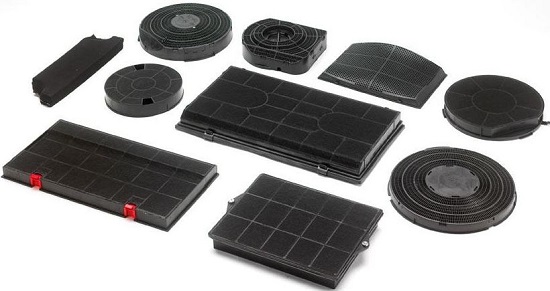
The timing of the replacement of the carbon filter is always individual, and depends on the following factors:
from the quality itselffilter element(cheap models will clog faster than better ones);
on what kind of food is cooked, and how often: if you cook borscht and fry meat every other day, then the filter will clog quickly.
On average, the service life of a set of carbon filters ranges from 2-3 weeks (with frequent cooking of "heavy" food) and up to 3-4 months (with less frequent use and cooking not too fatty and aromatic dishes).
By cost : 1 carbon filter can cost about 250 to 700 rubles (medium range). It is easy to calculate that if you change it once a month, and buy the most cheap option- then for the year it will cost an additional 3000 rubles.
2в1 - hoods with air duct and recirculation mode
There are 3 types of models on the market today:
Conventional hoods with an air duct that remove air from the kitchen.
Recirculating hoods that purify the air and feed it back into the kitchen.
Ducted models with recirculation mode. They can be used both as a conventional hood (which will remove air) and as a recirculation hood.

The third option appeared relatively recently, and the range of such devices is not very wide. Connecting the air duct is only necessary to remove air - that is, if you plan to use the hood only in recirculation mode, then it is not necessary to mount the outlet.
Models of this type are not particularly popular, and, in fact, are of little use for the following reasons:
they cost more than products with a single function;
the recirculation mode is less efficient than a conventional hood, so it is unlikely to be used in practice.
Mounting Features
As mentioned above, the installation of filter hoods is much easier and faster than products with an air duct.
To begin with, a place is selected for the location of the hood above the stove. Recommended height: for gas stoves: 75-85 cm; for electric stoves: 65-75 cm.
IN In the selected place, the case is hung on the wall (or on the ceiling - if the model is an island) on bolts.
Everything - no laying of air ducts, installation of grilles, installation of decorative cabinets - is not required.
List of models without outlet and models with two modes (hood / recirculation)
P Since the number of models is quite large - we will give only a few options, for example.
Models with recirculation only -are the least common, and not every manufacturer. Usually they are cheap, there are few expensive products in this category.
A few examples(at it seems the manufacturer, one of the models, and the price in rubles ) :
- Electrolux (EFP 6411 - about 4600 rubles).
- Cata (F 2050 - about 3500).
- Pyramida (WH 10-50 - about 2100).
- Kaiser (A 6413 - about 10300).
- Faber (Flexa HIP A 50 - about 5400).
- Elica (Concorde F / 50 - about 3000).
- Perfelli (DNS 6521 - about 16500).
- Falmec (Mimosa Parete 60,600 - about 20,000).
- Siemens (LI 28030 - about 17500).
- Hansa (OKC 5662 - about 7100).
Ardo (Basic F60 - about 3300).
A large selection of filtration models can be found at Cata, Electrolux, Pyramida, Kaiser, Falmec.
Models with 2 modes (removal and recirculation) are more common. Such products are produced by almost every manufacturer (some brands have more such models, others have less). You can distinguish them by the mode of operation, which indicates "removal / recirculation", or "hood / recirculation".
The hood in a modern house is a necessary element, since the level of comfort in its presence increases significantly. All such devices are divided into exhaust and circulation. Hoods with the removal of polluted air outside the premises are more efficient. But what if it is impossible to equip such an air duct? In this case, hoods without venting are used, which pass air through the filter system, returning it to the kitchen already cleaned.
Cooker hoods fall into two broad categories:
1. With air extraction (flow-through). In such devices, the fan draws in air, passes it through the grease trap, and then directs the polluted air into the duct. Through the channel, it is thrown out of the room. If the ventilation duct is functioning properly, the air in the kitchen is constantly updated. Instead of exhaust air, fresh air enters the kitchen. To ensure high-quality operation of the supply hood, a constant air flow into the kitchen from the street.
2. Without air extraction (recirculation). Such devices are not connected to air ducts. They work on the principle of air recirculation. The engine uses a fan that drives air through two degrees of filtration. The first stage is a grease trap, which, in addition to grease, also traps dust particles, soot, and heavy types of fumes. Next comes a carbon filter that cleans the passing air from foreign odors and the smallest particles that have passed through the grease trap.
The circulation hood does not require air to enter the kitchen. It only needs to be connected to the mains for its operation.
There are also types of hoods for the kitchen without an air duct:
Body shape:
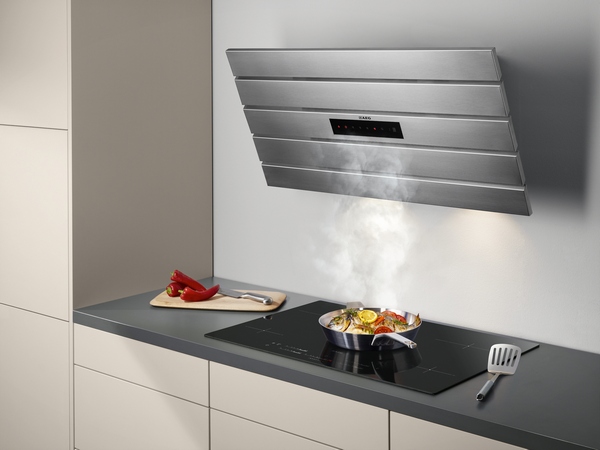
By design:
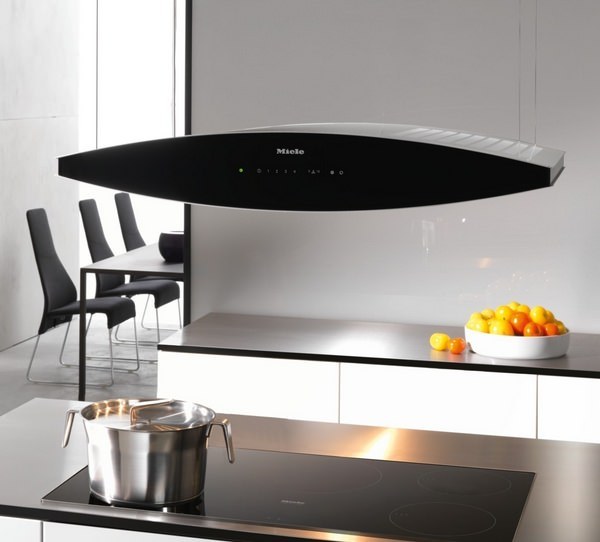
When does it make sense to install a recirculation hood?
There are many reasons why the installation of a flow-through exhaust device is not recommended:
- in a studio apartment. Additional air ducts that will be in plain sight will not add to the aesthetics of such a stylish apartment;
- if the stove is located very far from the entrance to the ventilation;
- if the kitchen was originally designed without taking into account the exhaust hood;
- air ducts laid through the entire room can spoil general form kitchens;
- ventilation ducts are not functioning properly. The air does not leave them, but returns back to the kitchen with all the available smells;
- air outlet channels, as well as the hood itself, do not fit into the interior of the kitchen.
We also note that kitchen hoods without a vent to the ventilation are much easier and faster to install.
Tip: If there is a geyser in the house, the circulation hood would be an ideal option, since the flow system can create reverse draft in the ventilation shaft.
Pros and cons of hoods without air extraction
Before choosing a kitchen hood without an air duct, we recommend that you familiarize yourself with the positive aspects of these devices, as well as find out their negative points. With this knowledge, you will be able to choose for your home a device that would completely suit you.
Let's start with the positives:
- the hood without a vent to the ventilation can be mounted not only in kitchens, but also in any premises, regardless of the presence of ventilation ducts in them;
- there is no need to ensure the flow of air into the room. This is especially important for kitchens in which sealed double-glazed windows are installed, plus cold air from the street into winter time will significantly cool the room;
- the circulation hood will perfectly fit into the interior of any kitchen;
- requires little space, does not clutter up even small kitchens with its presence;
- simple design that does not require special knowledge to connect. All work on its installation is easily performed independently;
- practically does not require maintenance;
- filters are replaced a short time on their own.
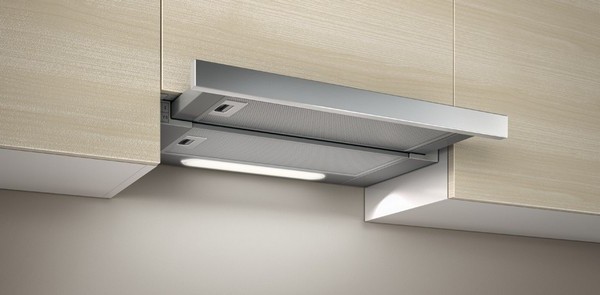
Hoods for the kitchen without an air duct are not without drawbacks:
- it is necessary to change the active filter element regularly, which leads to additional expenses. Usually the filter lasts for 3-6 months. After this period, the efficiency of the hood decreases;
- such a device has less efficiency than a flow hood;
- they are noisier.
What to look for when choosing
To choose the right circulation hood, you need to take some of your time to get acquainted with the main parameters of this technique:
Dimensions
The device should not be smaller than your stove. Let it be better that its dimensions go a little beyond the dimensions of the hob.
Performance
The higher this indicator, the more air the hood can clean in 1 hour. It is considered normal if the air is replaced in the kitchen 12 times. To determine the required performance of the hood, you need to know the dimensions of the kitchen. The total area is multiplied by the height of the ceilings, and then multiplied by 12. For example, if the area of the room is 9 squares, and the height of the kitchen is 3 m, then we get the required power: 9 x 3 x 12 \u003d 324 cubic meters / hour. This indicator is the minimum hood power suitable for installation in a given room, which is recommended to be increased by 30 percent.
Note: If the kitchen is combined with some other room, then it is taken into account total area such an association.
Speed control
A high-quality recirculating hood for the kitchen should have at least 3 speeds to ensure the convenience of working with different evaporation rates.
Backlight
This is a very convenient addition that allows you to illuminate the hob. As lighting elements, LED lamps look preferable.
Filters
The filtration system consists of an external filter (grease trap) and a carbon filter. As grease traps, reusable metal meshes or acrylic fiber inserts are used. Disposable filters include sintepon, paper and non-woven filters. It is better to use reusable elements due to their cost-effectiveness.
Additional functions
- the electronic display on the device panel will give all the necessary information about the performance of the hood without a pipe and its mode of operation;
- the filter status indicator will remind the hood owner of the need to replace or clean the filter element;
- sensors for automatic on and off will allow you to fully automate the operation of the device;
- the periodic inclusion mode will allow you to constantly maintain the freshness of the air in the kitchen;
- The built-in timer allows you to set the hood to work according to a schedule.
Popular manufacturers
Electric hoods for the kitchen without an air duct are produced by many manufacturers. Among them are the most famous, whose quality is the standard:
Bosch
A German company famous for its quality, which specializes in the production of household appliances for home and office.
Gorenje
A well-known Slovenian manufacturer whose products are among the top ten European models of household appliances.
Electrolux
The products of this Swedish brand are known all over the world. The basis of production is the production of electrical equipment for the needs of the population.
Ariston
One of the European leaders in the production of household appliances. Company from Italy.
In addition to the listed companies, the products of such manufacturers as Kaiser, Hansa, ARDO, Samsung, Zanussi have excellent quality.
When choosing a hood, focus on the affordability of the product, as well as on the functionality that it has.
tweet
plus
Without an air duct, it captivates with its versatility. The principle of its operation involves the purification of polluted air after suction by passing through filters.
Filtration system
Hoods of this variety are equipped with two types of filters.
Coal is based on the use activated carbon in the form of granules that absorb foreign odors. Such filters are operated for about two months, and then replacement follows.
Fat-absorbing provides a delay of tiny particles of fat and soot, without giving them the opportunity to penetrate directly into the mechanism. Its presence extends the operating period of the hood. Functional hood without outlet is equipped different types such filters:
- reusable made of perforated thin aluminum, quite whimsical and requiring care in care. Do not use cleaning products with abrasive fillers;
- reusable acrylic fiber filters must be washed without squeezing hard to avoid deformation;
- disposable filter products - made of synthetic winterizer, paper or non-woven fabric, have markings on the surface, by which you can independently determine the optimal period of its operation in order to replace it in time.
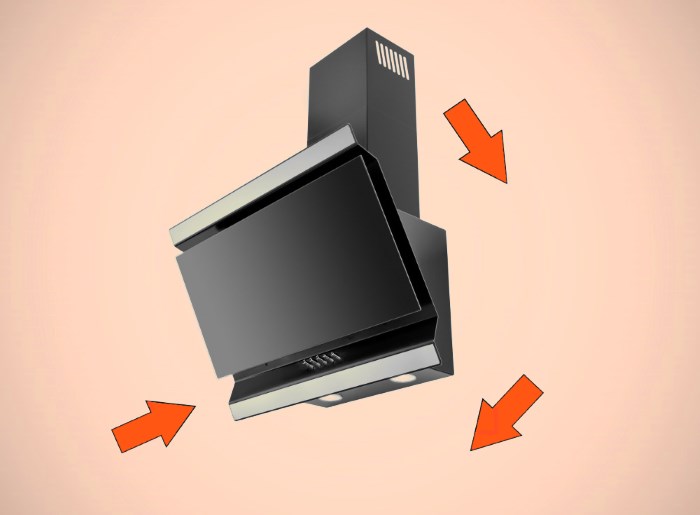
Criterias of choice
If it is decided to install a hood without a pipe in order to fix it yourself without difficulty, then at the preliminary stage you should decide which type is preferable.
- Flat hoods can be vertical and horizontal orientation.
- Chrome-plated models, as well as made of aluminum or glass, look stylish.
- Built-in types of hoods are mounted in the cabinet of the upper tier of the headset or in a niche behind a decorative facade panel.
- The telescopic version of the built-in hood is hidden in the cabinet when not in use, and is pulled out only when it is needed.
Attention is drawn to a number of characteristics of the hood for the kitchen without a drain, some of the parameters of which are selected taking into account the characteristics of the room and the dimensions of the hob.
- The width of the hood should not be less than the size of the plate.
- The average power rating with a mandatory safety margin can be calculated considering twelve air exchange revolutions. To do this, the volume of the room is multiplied by twelve.
- In order not to suffer from the annoying noise of a working hood, it is necessary to understand that its intensity is directly proportional to the power. Therefore, in a small room you should not strive to put an overly powerful device. You can find out all the parameters from a consultant in the store or by carefully studying the instructions. Permissible background noise level ≈ 40 dB.
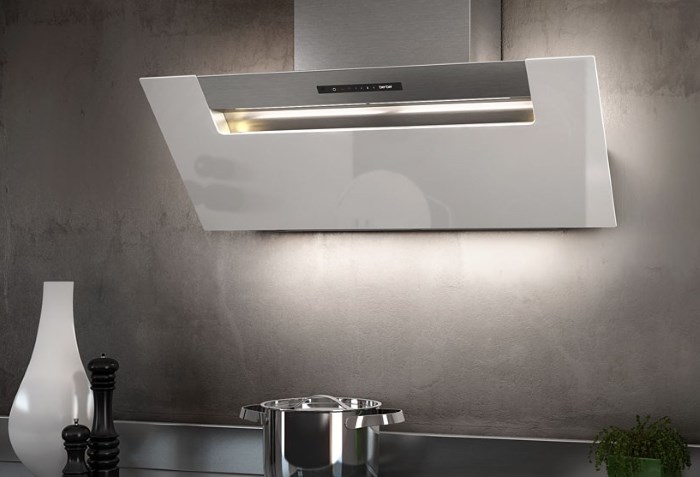
The most functional are hoods without an air duct, having a backlight and equipped with a speed switch. More prestigious and expensive products feature an elegant display that reflects the performance mode. They also have built-in clocks, sensors automatic shutdown, timer.
Advantages and possible disadvantages
Among the indisputable advantages of a hood without a drain in the kitchen, several indicators stand out:
- does not deliver additional loads to the ventilation system;
- does not require punching special holes during installation;
- works great in homes where ventilation is poor or non-existent;
- allows you to install a stove or an innovative hob anywhere, including on the central island;
- many are attracted by a simple one without a pipe, during which you only need to fix it in the right place and turn it on;
- the possibility of simple maintenance of reusable filters and self-replacement of disposable analogues that have served their standard period is provided;
- do not create an annoying background noise in the kitchen during operation;
- fit perfectly into the diverse style solutions of the kitchen space;
- the light weight of the device eliminates significant loads on the surfaces to which they are attached;
- these models are cheaper than flow hoods and at the same time clean the kitchen air well, creating a comfortable atmosphere.

The main disadvantage of a hood without an air duct, many owners consider the rather frequent replacement of filters, which entails additional financial costs.
Experts note that the cleaning efficiency is lower in this variety compared to the flow system. It provides predominantly the absorption of soot and fat particles, without affecting the reduction of moisture, and there is also a uniformity of external forms.
The most famous brands of hoods
High-quality hoods without a tap are offered by many reputable and well-known companies that have long earned trust:
- Ariston products are rapidly conquering the consumer market, guaranteeing impeccable operational durability.
- Modern functional options provided in Integra hoods allow you not to be disappointed in their work on air purification.
- The German quality of Bosch products, known and highly valued all over the world, becomes the key to a constant supply of fresh air to the kitchen.
- Not inferior in the splendor of design and reliability of construction and another German manufacturer "Zigmund-Shtain".
The range of modern hoods for the kitchen without an air duct is constantly expanding and in stores you can find products from other reputable companies. This makes it possible to choose the right device.
Hard to imagine modern kitchen without household appliances, and without a stove and a refrigerator - it is almost impossible. In the same way, there are no apartments left in nature, the kitchens of which are not equipped with hoods, or as they are also called exhaust hoods. It is these structurally simple products that remove air polluted with fatty inclusions, excess moisture and combustion products, thereby allowing us to breathe fresh air.
But most of our apartments are equipped with one ventilation duct in the kitchen, and the second in the bathroom. By connecting an exhaust hood, most people are deprived of the only exhaust outlet in their own kitchen. In fairness, it should be said that when the hood is working, the polluted air is perfectly removed from the kitchen. But what happens when the hood is turned off?
The natural circulation of air in our home is disturbed, and this inevitably leads to stagnation of air masses in the room. It was in order to free the ventilation duct that the kitchen hood was invented without a vent to the ventilation.
The principle of operation of the exhaust hood without an air duct
Such kitchen umbrella, outwardly practically does not differ from standard hoods. Its only difference is that it does not need a ventilation system for operation and it does not remove air, as it works in recirculation mode.
 The principle of operation of the umbrella is extremely simple: the fan sucks in polluted air from the kitchen, which immediately enters the filtration system, where it is cleaned of unpleasant odors, fat deposits and excess moisture. After cleaning, the air is re-entered into the room. Air recirculation in the hood is the basic principle on which all its work is built. The quality of air purification depends on only two factors:
The principle of operation of the umbrella is extremely simple: the fan sucks in polluted air from the kitchen, which immediately enters the filtration system, where it is cleaned of unpleasant odors, fat deposits and excess moisture. After cleaning, the air is re-entered into the room. Air recirculation in the hood is the basic principle on which all its work is built. The quality of air purification depends on only two factors:
- Device power.
- filtering system.
Filter systems used in kitchen umbrellas
A modern kitchen hood without air outlet into the ventilation duct is a high-tech equipment that, despite its simple design, has several stages of air purification. In the most common and affordable models, there are two of them.
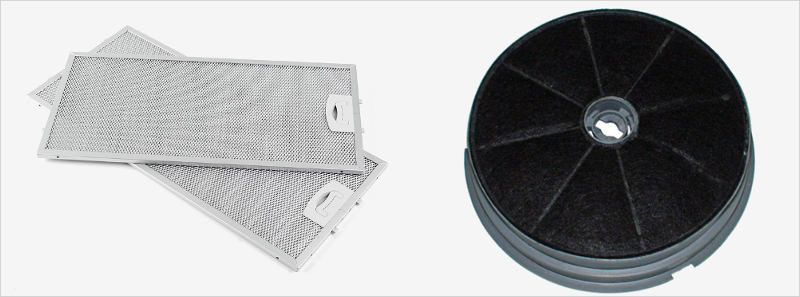
Types of kitchen umbrellas
All without exception kitchen hoods with a filter without a tap, they use the same principle of operation, but there are still differences between them, according to the method of their installation.
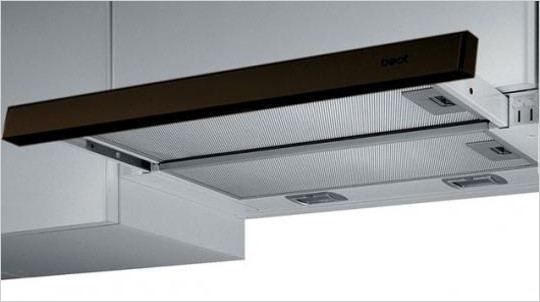
Hoods without a drain can have different functional solutions, depending on where they will be installed. There are standard wall-mounted hoods, there are island and corner models. All this is done to create maximum user convenience.
Advantages and disadvantages of exhaust hoods without an air duct
Like all kitchen Appliances. Such equipment has undeniable advantages and rather serious disadvantages. The advantages of these hoods are:
- In ease of installation. To connect the hoods, air ducts and additional ventilation grilles are not needed. Any home master will install such a kitchen umbrella in his own kitchen in a matter of minutes.
- Hoods of this design use less electricity to operate, so they are more economical than ducted models.
- This household appliance is quite cheap. Those who are experiencing financial difficulties should consider these models for purchase.
And now a few words about the shortcomings, or rather, about one, but a serious drawback of umbrellas of this design.
The main and only disadvantage of kitchen umbrellas of this design worthy of consideration is regular replacement of filter elements. Depending on the frequency of use, the carbon filter for the hood will have to be changed every 3-6 months.
Rules for choosing kitchen hoods
To choose the right exhaust equipment you need to know the performance required for your premises. Calculating it is quite simple: kitchen area should be multiplied by 12. The resulting figure will be an indicator of the device performance you need. In some cases, if the kitchen area is large, it is better to opt for devices connected to the ventilation system. They are produced with a sufficient power reserve.
Some complain about the limited design choices of these devices. If the appearance of the appliance is the most important criterion for choosing a hood, then you should pay attention to the variety of hoods with duct connection.
Almost all models without duct connection are quite noisy. And if the noise indicator is critical for you, then you should give your preference to plug-in models of hoods.
Choose a device in which the grease filter for the hood will consist of 5 or more layers of aluminum mesh. Grease filters with fewer layers are ineffective.
Advice:
If your home has quality plastic windows, and there is only one ventilation duct in the kitchen, then it is worth buying a kitchen umbrella without connecting to the ventilation air duct. Leave the duct open ventilation system, as it will regulate the air exchange and the removal of exhaust air masses from your home, at the moment when the umbrella is inoperative.
Kitchen hood without duct
It is impossible to imagine a modern kitchen without a hood, which saves the room from fumes and odors during cooking. This problem is most relevant in apartments with a living room, where the kitchen is connected to the seating area and therefore it is not possible to close the door during cooking.
In some apartments, the gas stove and the ventilation shaft are located at a considerable distance from each other. Such apartment owners are most often interested in the question: “Is there an extractor hood without an air duct?”
Available two types of designs of exhaust devices for the kitchen: exhaust air and circulating air. Circulation models - hoods with a filter without an air duct, flow-through - remove combustion products through an air duct into the ventilation system.
General principles of operation of the hood
 The principle of air exchange is embedded in the operation of flow devices with an air duct. The steam drawn into them or kitchen air is thrown out through the ventilation channel into its common system or to the street. The effectiveness of these hoods is in the complete removal of polluted air from the premises and freeing up space for clean. Such models require mandatory installation to the ventilation system or the outlet of the duct to the street.
The principle of air exchange is embedded in the operation of flow devices with an air duct. The steam drawn into them or kitchen air is thrown out through the ventilation channel into its common system or to the street. The effectiveness of these hoods is in the complete removal of polluted air from the premises and freeing up space for clean. Such models require mandatory installation to the ventilation system or the outlet of the duct to the street.
Circulating devices work on a different principle. Thanks to a powerful motor, they draw dirty air into their tank, clean it with filters and return it back to the kitchen. These hoods use two levels of filtration. One filter purifies the air of soot and soot, the other filter removes substances that create unpleasant odors.
Advantages of a hood without an air duct
- The main advantage of this model is no obstruction to natural air exchange in the room. If you turn off the flow hood, then the duct pipe will block the ventilation duct of the house. And because of this, there will be no natural exchange of air in the room. For the inflow of fresh air, it will be necessary to open the windows. This does not happen with models without an air duct. When the hood is turned on, it simply circulates air, and when turned off, it does not interfere with the natural exchange of air.
- The second tangible advantage of this model is the simplicity of its design. It does not need to be pulled to the ventilation connections, since it does not have bulky pipes. And having a compact flat surface, horizontally located on the floor, the hood does not give an additional load on the wall and does not visually overload the kitchen.
- The next positive aspect of this model is the ease of installation. With the help of common tools used in everyday life, you can fix the hood to the right place and connect it to the electrical network. And she works.
- The advantage of this kitchen model is also easy replacement or maintenance of filters. Made of metal, the coarse filter can be washed in dishwasher or any non-abrasive detergent. Carbon filters are replaced with new ones.
- The undoubted advantage of circulating devices is an affordable price. They are cheaper than flow hoods. And you can save on installation. After all, this does not require specific skills.
Disadvantages of a hood without an air duct
Of course, hoods without an air duct are not an ideal creation of nature and have the following disadvantages.
- Requires regular replacement carbon filters. This incurs additional costs. It is impossible to unambiguously determine the life of the carbon filter. It depends on many factors. These include the frequency and intensity of use of the device. For a large family, you have to cook more, so the filter life will be shorter than when used in a family with a small number of people. In addition, the intensity of the filter is affected by the presence of smokers in the family, and the preferred menu - eating dishes with cooking. a large number fat. All this increases the intensity of the use of equipment. Therefore, on average, carbon filters must be replaced after 3 to 6 months. But even modern models of flow devices have filters that need to be changed after a set time.
- The next disadvantage is the lack of design variety of hoods without an air duct. Most often, these models have a noble, simple and concise appearance.
- Public opinion is also negative. Most buyers believe that models without an air duct for the kitchen are worse than flow ones. But it's not. These devices provide a good level of air purification, and maintain the balance of ventilation in the house.
Different types and types of hood devices for the kitchen
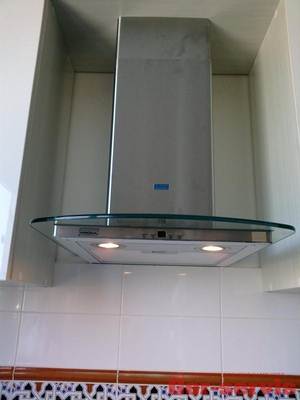 flat hood. This device consists of a case panel, filters and a fan. They are both horizontal and vertical. Having a compact size, the models organically fit into the kitchen space of any size. Chrome-plated models, as well as those made of aluminum and glass, look more aesthetically pleasing and modern.
flat hood. This device consists of a case panel, filters and a fan. They are both horizontal and vertical. Having a compact size, the models organically fit into the kitchen space of any size. Chrome-plated models, as well as those made of aluminum and glass, look more aesthetically pleasing and modern.
Built-in hood. This ductless kitchen appliance fits perfectly into any interior, as it is covered with a panel or wall cabinet. A convenient solution can be a telescopic model, which is a kind of edging. It can be pulled out when cooking and completely removed when not in use.
Additional functions of hoods without an air duct
On the modern market, you can find a variety of kitchen hoods without an air duct. They differ in different design and different dimensions, type of installation and available additional functions. The kitchen air duct without a pipe in the basic set has a speed switch and built-in lighting.
Luxury models have other convenient features. These include automatic sensors with an on/off function. They independently react to temperature and changes in air humidity and choose the optimal mode of operation. With the presence of a filter clogging indicator, it is possible to plan the replacement of filters. There are functions of modes of intensive and periodic work, which provide normal ventilation even during your absence. The available remote control allows you to control the operation of the device from any corner of the kitchen.
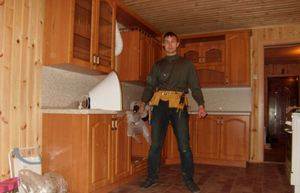
Hood without air duct - this is an excellent solution for equipping a ventilation system in kitchens of various sizes .
More information



